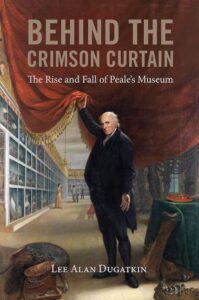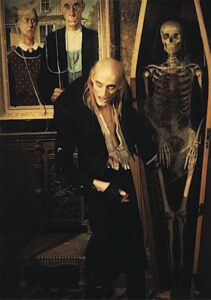 I’m relatively confident that the fact that whenever I see an image of Charles Wilson Peale pulling back a luxurious crimson curtain in his famous self portrait “The Artist in His Museum” and immediately recall the character Riff Raff, expertly portrayed by Richard O’Brien, opening an upright coffin in the The Rocky Horror Picture Show says absolutely nothing good about me whatsoever. Nevertheless, that’s precisely what happened once again when I opened the recently arrived package containing Lee Dugatkin‘s newly published Behind the Crimson Curtain: The Rise and Fall of Peale’s Museum from Butler Books.
I’m relatively confident that the fact that whenever I see an image of Charles Wilson Peale pulling back a luxurious crimson curtain in his famous self portrait “The Artist in His Museum” and immediately recall the character Riff Raff, expertly portrayed by Richard O’Brien, opening an upright coffin in the The Rocky Horror Picture Show says absolutely nothing good about me whatsoever. Nevertheless, that’s precisely what happened once again when I opened the recently arrived package containing Lee Dugatkin‘s newly published Behind the Crimson Curtain: The Rise and Fall of Peale’s Museum from Butler Books.

That’s not to make any manner of inference about to Mr. Peale, Prof. Dugatkin, or the quality of the book itself. Indeed, the history of Peale’s famous Philadelphia, Pennsylvania museum, opened in 1786, is one that is well worth a fresh look. Serving as Peale’s studio and gallery, as well as a publicly accessible museum of natural history, it quickly became famous for both its quality as well as its reflection of Enlightenment ideas in natural philosophy as well as regarding societal accessibility to the arts and sciences.
If Prof. Dugatkin’s previous work is any indication as to what we may expect in this most recent book, it is highly likely that it will prove both very lively and informative indeed. (And my apologies for the “Time Warp” ear worm I’ve likely now given you.)
